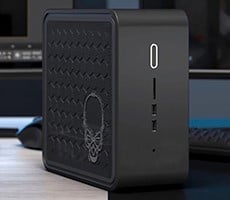Lenovo ThinkCentre M90z Review
The bundled mouse and keyboard with our test unit looked a bit more dated than the two pictured in many of the M90z press photos. That said, both functioned fine, and while they offered no extra functionality (no hot keys or macros on the keyboard, and no side buttons on the mouse), they both suffice if you're saddled with traditional office tasks. The LCD, as mentioned before, is one of the major highlights. With the glossy touch panel, colors are sharp and crisp, while the 1080p native resolution enables Full HD content to be displayed as it was meant to be. The system could double as a great little DVD/TV setup for a bedroom, if you've been considering as much.
Overall performance was decent, but for around $1,400, we expected more. Application load times were somewhat disappointing, and in general, we felt that the hard drive was both sluggish and too noisy. Also, for $1400, we really expected a discrete GPU. The Core i5 is great, but for tasks that don't require a dedicated GPU, a Core i3 would've had nearly identical perceived performance in most desktop scenarios. Nothing in particular felt slow, but we just didn't feel that the M90z was as snappy as a $1400 quad-core machine should be.
While we're on the topic of hard drives, the Seagate Barracuda 7200.12 ST3500418AS that was installed was surprisingly loud. We could hear each and every seek even from a few feet away. We got the impression that Lenovo had enough space in the case to dampen some of that but chose not to. Also, a slot-loading optical drive is always preferred in an all-in-one machine; the tray-load one here means that you'll have to arrange to keep the machine a certain distance from your wall in order to insert discs.
The integrated GMA HD graphics were fine for playing back HD media (even 1080p) without any trouble, and it managed to handle a few FPS titles from yesteryear. It's obviously not capable of playing the latest titles at a decent resolution; but again, this is a machine designed to get work done, so play time always comes second. We will point out, however, that there are all-in-one machines on the market today for well under $1400 that have discrete GPUs (the iMac at $1199, as an example), mostly paired with Core i3 processors. If you need 3D performance, you're better off with a Core i3 + discrete GPU versus a Core i5 + integrated graphics.

Finally, we'll get to the touch features. To put it bluntly, they're mostly a waste. Don't get us wrong, the functionality is great. And touch response on the system was excellent, so we can't knock the implementation.











